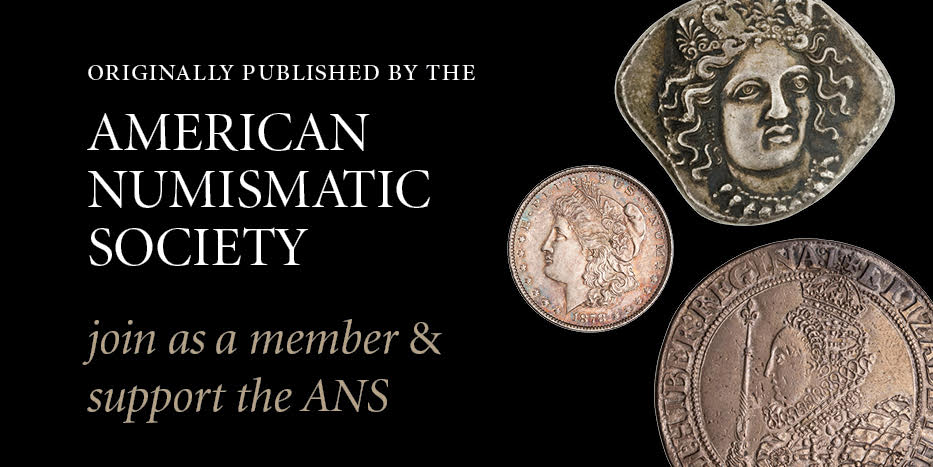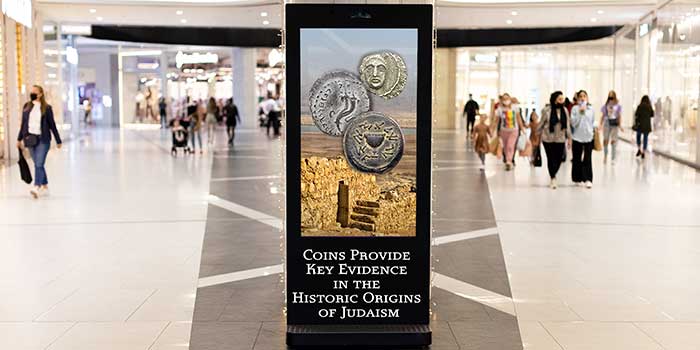
By David Hendin for American Numismatic Society (ANS) ……
All coin images in this post appear in Hendin’s Guide to Biblical Coins (6th Ed.) and are used here by permission
Long-held tradition tells us that the Jewish religion dates back some 3,000 years. Most contemporary scholars, however, consider the story of the Exodus and the giving of the Ten Commandments as foundation myths.
A newly published historical reappraisal of The Origins of Judaism: An Archaeological-Historical Reappraisal by Yonatan Adler, suggests that Jews became a singular group when they began following the practices and prohibitions discussed in the Torah much later—only during the early Hellenistic Period or following the Maccabean Revolt. Among the practices he discusses are dietary laws, ritual purity, Sabbath regulations, synagogue worship, holidays, and the use of graven images.
The date Adler proposes for the widespread adoption of Judaism is nearly a thousand years after the Iron Age Israelites settled in Jerusalem. Adler, an Israeli archaeologist and historian, is an associate professor of archaeology at Ariel University in the West Bank. Adler says that some Judeans may have known about the early practices and prohibitions, but this “does not imply that anybody was necessarily putting (these) into practice.” Adler says it was possible that priests or another small group of Judahites may have followed some aspects of Torah before Hellenistic times.
Adler presents evidence powerfully but makes conclusions cautiously. He told Israel’s Ha’aretz newspaper that “I can’t swear on the bible there was no Judaism before; I can only say there is no evidence for it, and I can say we have some counterevidence for it, especially in the Persian Period, so it’s less likely, while the second century BCE is the more probable setting for the birth of Judaism.”
Adler’s research has shown that Judahites consumed non-kosher fish at least up to the Persian Period (catfish bones are found in excavations of the period). He also notes that prior to the second century BCE there is no archaeological or textual evidence for Jewish ritual baths (mikvehs) and synagogues, the use of chalkstone vessels for food purity, the existence of tefillin (phylacteries), or the observance of the Sabbath or Passover.
An Elephantine Island (Egypt) letter from the late fifth century BCE mentions a spring festival among Judahites, but Adler points out that the rites of Passover are never mentioned. Other ancient texts from Judahite communities often invoke the blessings of “all the gods,” which may include Anat, consort of YHWH, among others.
Adler observes that Solomon’s First Temple “is said to have been filled with sculpted and embroidered images of bulls, lions, and winged cherubim—none of which seem to have provoked the ire of the biblical authors.” The cherubs were certainly graven images. It is ironic that Exodus 25: 18–22 says cherubim appear on the very Ark of the Covenant that contained the commandment against making graven images!
This underlines Adler’s explanation that his main concern is not, for example, when a practice such as the prohibition against figural art came into existence, but instead when it became widely practiced and generally regarded as authoritative. Adler writes that his own interest, “is decidedly not in the history of ideas or intellectual history, but rather in social history, focused on the behavior of a society at large.” He asks the essential question of when the “rank and file” Judahites adopted the Torah as “their authoritative law.”
Given Adler’s idea that few Judahites observed the Torah before the Hasmonean (Maccabean) Revolt, he suggests that the conflict may have been more about the Hasmoneans seizing power and asserting Judea’s independence. It was only in subsequent telling and retelling of history that it morphed to more of a holy war to unite the Hasmonean Period Jews under a common identity integral with the laws and origin stories in the Torah.
It was also politically helpful that the Torah’s territorial claims over the entire Holy Land as given by God to the people of Israel, providing useful justification to later expansionism. When the Hasmoneans captured areas that were not inhabited by Jews (such as Idumea), non-Jewish inhabitants–including the ancestors of Herod I–were forced to convert to Judaism.
Hasmonean rule began during conflict with the Seleucid king Antiochus IV, who wanted to force Jews to fully adopt Greek life. The Seleucid defeat, celebrated today as Chanukah, is recalled as a victory against Greeks forcing Jews to abandon Torah law and assimilate. By this time in history, according to Adler, most Jews were “deeply embedded in a world dominated by Hellenistic culture.”
Since Adler believes an undetectable number of Judeans observed the Torah before the Hasmonean revolt, he suggests that the conflict may have been more about Hasmonean political victory and the independence of Judah. In a recent lecture, Adler pointed out that Hasmoneans needed something to unite their people and the Torah served that purpose—sort of parallel to the United States’ Declaration of Independence and Constitution.
Israel Finkelstein, a leading Israeli archaeologist at Tel Aviv University and the University of Haifa, agrees with Adler about the importance of religious ritual in Hasmonean Judea. Finkelstein says that, while there is no doubt that portions of the biblical text had already been composed in the First Temple Period, “they cannot be described as representing Judaism, but rather Judahite theology and royal ideology.”
Adler compares Judaism with an earlier version of what has been referred to not only as “Judaism” but “Judahite” or “Yahweh-ite” tradition. The archaeologist recognizes and discusses the existence of certain aspects of Judahite traditions going back to the Iron Age. Indeed, most current scholars agree that the religion of the ancient Israelites were different in many ways from the Judaism of today. They may have worshipped Yahweh, but other gods in the form of human figures are found in Judean ruins of the times.
Our special interest in Adler’s work stems from his use of numismatic reference points from the Persian to early Hellenistic Periods as well as the Hasmonean and Jewish War (Great Revolt) coinage to support his theory.
During the Persian Period, according to the second commandment, there was a strict taboo against graven images. But this taboo may have also been a later development considering, for example, coins of the Persian Period struck in the southern Levant.
In every instance, those coins–struck between the Persian and the Ptolemaic Periods–bore graven images such as the goddess Athena, birds, winged lions, and human rulers portrayed as gods or goddesses.
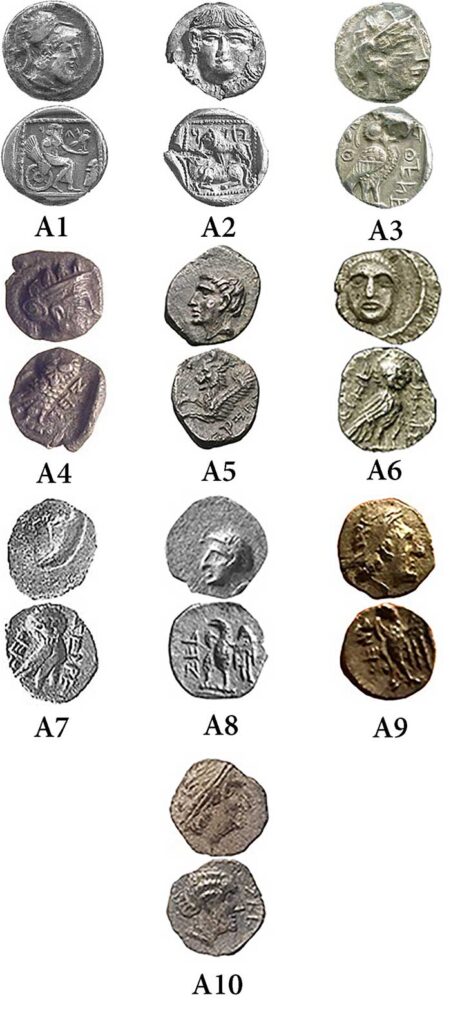
Persian Period (early 4th century to 333 BCE)
A.1. Silver quarter-sheqel (3.2–3.5 g). Bearded male head (Bagoas?) r. wearing Corinthian Helmet. R: YHD above bearded deity seated r. on winged wheel, holds falcon in l. hand and r. hand rests on knee, small bearded mask below r. GBC 6046.
A.2. Silver quarter-sheqel (3.2–3.5 g). Gorgoneon facing. R: YHD above lion facing l., on top of recumbent bovine, head turned. GBC 6047.
A.3. Silver quarter-sheqel (3.2–3.5 g). Athena head r. wears decorated helmet. R: YHWD on r. of owl stands to r. head facing, two o flank the owl. GBC 6049.
A.4. Silver gerah (0.6 g). Athena head r. wears decorated helmet. R: YHD to right of owl standing to r., head facing. GBC 6051.
Macedonian Period (c. 333–302 BCE)
A.5. Silver half-ma’ah-obol (0.36 g). Young male head l. R: HEZEKIAH (paleo-Hebrew) beneath forepart of winged, horned, lynx. GBC 6064.
A.6. Silver quarter-ma’ah-obol (0.18 g). Facing head. R: YOHANAN THE PRIEST (paleo-Hebrew) flank owl standing r., head facing. GBC 6071.
A.7. Silver quarter-ma’ah-obol (0.18 g). Facing head. R: YHD YHDH (paleo-Hebrew) flank owls standing r., head facing. GBC 6072.
A.8. Silver quarter-ma’ah-obol (0.18 g). Young male head l. R: YHD to l. of eagle standing l. GBC 6078.
Ptolemaic Period (c. 294–241 BCE)
A.9. Silver quarter-ma’ah-obol (0.18 g). Ptolemy I diademed head r. R: YHDH (paleo-Hebrew) to l. of eagle standing l. GBC 6081.
A.10. Silver quarter-ma’ah-obol (0.18 g). Ptolemy I diademed head r. R: YHD (paleo-Hebrew) to r. of head of Berenike I. GBC 6083.
These small silver Yehud coins also carry the name (YHD) of the Persian province for Judea and that name was stamped upon them—the first, rare examples struck at Gaza and later examples struck in Judea. These sometimes carried the names of individual officials—Judah, Hezekiah, or Yochanan—right alongside the heathen images and the name of the province. Archaeological evidence shows that these coins were widely used by the population in spite of biblical prohibitions. Adler suggests this was because in the fourth century BCE, Jews were still governed by “cultural norms and traditions inherited from the Iron Age”—that is, the era following the Israelite arrival in Jerusalem.
Adler suggests that the rise of standard Jewish practices coincided with Judean independence from Hellenistic control. In the second century BCE, the Judean Hasmonean dynasty began to issue coins that absolutely omit animal and human images. During this era, Adler believes, Judeans became more familiar with scripture and began to abide by its lists of rules on a daily basis as a way to distance themselves from their former overlords.
Complete elimination of depictions of humans and animals from the motifs on coinage was “in stark contrast to coinage minted practically everyone else in the Roman world,” Adler observes. He points out that this is also true for hundreds of excavated Judean tombs from the first century.
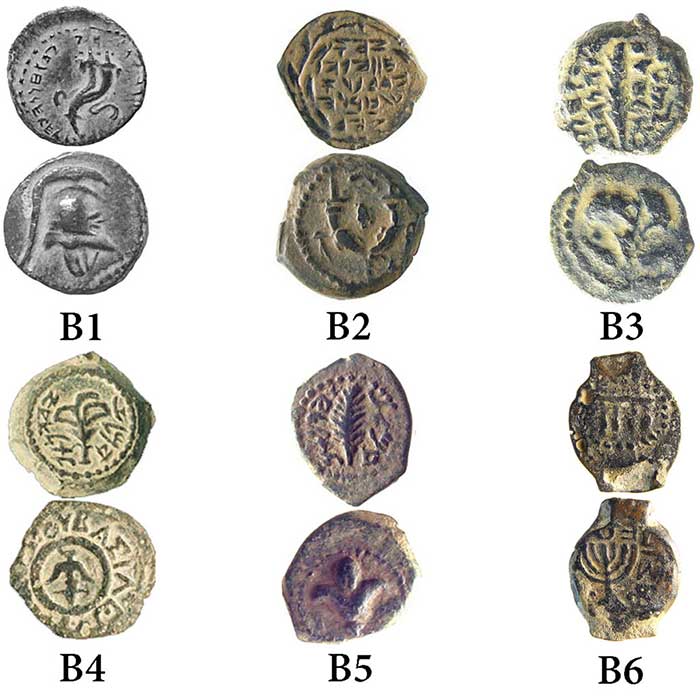
B.1. Bronze 2 prutot (18 mm). YEHOHANAN THE HIGH PRIEST [AND] HEAD OF [THE] COUNCIL OF THE JEWS (paleo-Hebrew) around 2 decorated cornucopias. R: Helmet with decorative crest. GBC 6167.
B.2. Bronze prutah (15 mm). YEHOHANAN THE HIGH PRIEST [AND] HEAD OF [THE] COUNCIL OF THE JEWS (paleo-Hebrew) in 5 lines within wreath. R: Two cornucopias splayed outward, adorned with ribbons, pomegranate or poppy between. GBC6168.
B.3. Bronze half-prutah (11 mm). YEHOHANAN THE HIGH PRIEST [AND THE] COUNCIL OF THE JEWS (paleo-Hebrew) flank palm branch. R: Rose between two ears of grain. GBC 6173.
B.4. Bronze prutah (15 mm). YEHONATAN THE KING (paleo-Hebrew) on sides of rose. R: BAƩIΛEΩƩ AΛEΞANΔPOY (of King Alexander) around inverted anchor. GBC 6184.
B.5. Bronze half-prutah (11 mm). YEHONATAN THE KING (paleo-Hebrew) on sides of palm branch. R: Lily. GBC 6183.
B.6. Bronze prutah (15 mm). MATTATAYAH THE PRIEST (paleo-Hebrew) around show bread table. R: BACIΛEΩC ANTIΓONOY (of King Antigonus) around 7-branched menorah. GBC 6203.
Replacing a royal or mythical bust on Hasmonean coins is a long inscription naming the “High Priest and head of the Council of the Jews.” These long paleo-Hebrew legends (25 tiny letters crammed in a disk around 13–16 mm in diameter) appear on Hasmonean coins. Adler refers to them as “textual portraits—lots of letters in a very small space.” The other side of the common Hasmonean coins show objects derived from Hellenistic iconography. However, these objects, such as cornucopias and grains, are portrayed that shows deliberate compliance with graven image prohibition.
Coins of the Jewish War (also called the Great Revolt) illustrate part of Adler’s discussion of celebration of the Festival of Sukkot (Tabernacles or Booths). The Torah itself points to general methods of celebration using “products” and branches of certain trees. It was only toward the end of the Second Temple Period that we begin to see evidence of wide-scale use of “the four species” (the lulab and etrog) on Sukkot, which continues until today. Early texts describing Sukkot rituals include The Temple Scroll and Jubilees, both of which likely date to the second century BCE. Adler cautiously observes, neither document “necessarily depicts a reality of large-scale observance of the central Sukkot rituals in Hasmonean times (they also in no way suggest against such a possibility).”
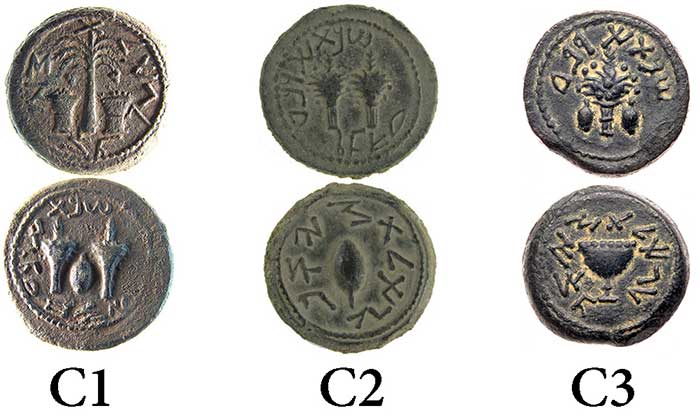
C.1. Bronze half-sheqel (26 mm). YEAR FOUR, HALF (paleo-Hebrew) around etrog flanked by two lulab bunches. R: TO THE REDEMPTION OF ZION (paleo-Hebrew) around seven-branched palm tree with two bunches of dates, flanked by baskets of fruit. GBC 6396.
C.2. Bronze quarter-sheqel (22 mm). YEAR FOUR, QUARTER (paleo-Hebrew) around two lulab bunches. R: TO THE REDEMPTION OF ZION (paleo-Hebrew) around etrog. GBC 6397.
C.3. Bronze eighth-sheqel) (20 mm). YEAR FOUR (paleo-Hebrew) around lulab flanked by 2 etrogs. R: TO THE REDEMPTION OF ZION (paleo-Hebrew) around ceremonial chalice. GBC 6398.
Adler notes that “all three denominations of the bronze coins minted the fourth year of the Great Revolt (69/70 CE) featured variations on the “four species motif.” The bronze half-sheqel depicts two lulabs and an etrog grouped together; the quarter-sheqel shows an etrog on one side and two lulabs on the other; and the third denomination carries a lulab flanked by two etrogs. This series of bronze coins was early siege money. The larger two denominations carry the denominations “half” and “quarter”, and there is general agreement that this series of three coins was emergency bronze coinage used to replace silver, in very short supply during the siege before the destruction of Jerusalem.
While some aspects of Adler’s hypothesis are apt to be controversial, it is likely that his point of view will be well represented in all future discussions.
Andrew Lawler, author of Under Jerusalem: The Buried History of the World’s Most Contested City, wrote in Smithsonian Magazine that Adler “concludes that ordinary Judeans didn’t consistently celebrate Passover, hold the Sabbath sacred or practice other traditional forms of Jewish ritual until a century or so before the birth of Jesus. If his theory proves correct, then Judaism is, at best, Christianity’s elder sibling and a younger cousin to the religions of ancient Greece and Rome.”
* * *
David Hendin is First Vice President, an Adjunct Curator at the American Numismatic Society (ANS). and winner of the 2022 Burnett Anderson Award for Excellence in Numismatic Writing. His most recent book is the sixth edition of Guide to Biblical Coins, published by the ANS in 2022. Send David your questions at [email protected] and he will try to answer questions of general interest in this space in the future.
* * *


